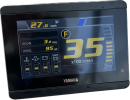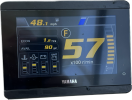Wow some very different advice from what I do. I think Seasick gave good advice, trim it all the forward, get on plane, watch your mpg, start trimming it back and the mpg will go up (a little, for me it is .1 mpg so it is subtle). Keep going as long as the mpg goes up, as soon as it goes down, you have gone too far.
For the first couple of years, I ran my 228 with the engine trimmed all the way forward, that's what the Grady tech guy said to do. Reason is that the cavitation plate acts as a trim tab, when the engine is forward it will lift the stern, push the bow down, the boat cuts through waves better.
I would NEVER run my boat with the engine trimmed back 50-70%, that will lift _my_ bow like crazy which means I am smacking into the face of each swell and I'm launching off the top of each swell. Maybe you Florida people can do that, but that is the path to a back that won't work for a week if you are on our Pacific.
These days, because my buddy Jens made me upgrade my trim tabs to the proper size (according him and Bennett), I do trim my engine back about one additional bar on the display, that's my MPG sweet spot. Then I use the tabs to push the bow down.
Whatever you do with all us internet people, just think. The engine trim affects your ride, trim it forward, the bow goes down, trim it back, the bow goes up. If you get the cavitation plate parallel with the ocean surface, that's the least drag, the most MPG. In most cases that is what you want. If you don't have trim tabs and you are in slop, you want that engine trimmed forward so you push the bow to cut through the waves. If you have trim tabs, learn from as I have learned from people here, use them. And be aware that on many Gradys the tabs are way too small. Bennett says for 9 inch deep tabs, you want an inch in width for each foot of hull. Grady gave me 9x12 tabs for a 22 foot boat. Ouch. I went to 12x18 and it is night and day better.



